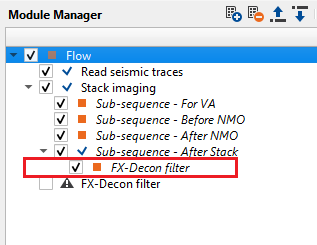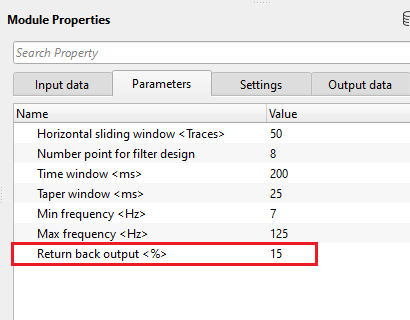Random noise attenuation using FX Decon filter
![]()
![]()
FX Decon filter module is designed for random noise attenuation. Data from T-X (Time - Space) domain is converted to F-X (Frequency-Space) domain using Fourier transformation along the time axis. A predictive deconvolution filter operator is calculated and used in T-X domain window for coherent impulse selection. This Decon prediction filter is applied to the data by working on each trace by trace with each frequency slice.
FX Decon predictive filter is useful in attenuating the random, incoherent noise. It is also used to attenuate the multiples since the multiples are predictable with their predictability where the primaries won't have the spatial predictability.
![]()
![]()
Input DataItem
Input gather - FX Decon filter should be used on cmp gather or post-stack gather to attenuate any random, incoherent noise. Connect/reference to output gather.
![]()
![]()
Horizontal sliding window - specify the number of traces should be used in designing the prediction filter. These traces are moved in sliding order based on the user defined parameters. Minimum horizontal sliding window should be 5. Shorter horizontal window is useful where the prediction is localized. With higher/longer horizontal window, it improves the frequency resolution however smears the data especially the dipping events. Depending on the geological setup, choose the appropriate parameters.
Number point for filter design - specify the total number of coefficients required to design the prediction filter. The longer the prediction filter points, the better suppression of the noise however it may distort the primary signal. Number of filter points should be less than that of horizontal sliding window.
Time window - within the user defined time window, deconvolution filter applied spatially to the input data. Specify the time window. Minimum time window should be 200 ms. Recommended shorter time window.
Taper window - taper parameter is essential to avoid any edge effects/sharp boundary when applying the deconvolution prediction filter within the user defined and time and horizontal sliding window parameters.
Min frequency - specify minimum frequency that should be considered
Max frequency - specify maximum frequency that should be considered
Return back output - this allows the user to choose how much percentage of original data should be added/mixed back to the filtered data after applying FX Decon filter. Specify the % of input data should be mixed back.
![]()
![]()
Auto-connection - By default, TRUE(Checked).It will automatically connects to the next module. To avoid auto-connect, the user should uncheck this option.
Bad data values option { Fix, Notify, Continue } - This is applicable whenever there is a bad value or NaN (Not a Number) in the data. By default, Notify. While testing, it is good to opt as Notify option. Once we understand the root cause of it,the user can either choose the option Fix or Continue. In this way, the job won't stop/fail during the production.
Notify - It will notify the issue if there are any bad values or NaN. This is halt the workflow execution.
Fix - It will fix the bad values and continue executing the workflow.
Continue - This option will continue the execution of the workflow however if there are any bad values or NaN, it won't fix it.
Calculate difference - This option creates the difference display gather between input and output gathers. By default Unchecked. To create a difference, check the option.
Number of threads - One less than total no of nodes/threads to execute a job in multi-thread mode. Limit number of threads on main machine.
Skip - By default, FALSE(Unchecked). This option helps to bypass the module from the workflow.
![]()
![]()
Output DataItem
Output gather - generates the FX Decon filter applied output gather. This can be used as an external output or connect/reference to any other module.
Gather of difference - generates the difference gather before and after application of FX Decon filter.
There is no information available for this module so the user can ignore it.
![]()
![]()
In this example workflow, we apply FX Decon filter on a post stack gather to attenuate the random noise. FX Decon filter can be added within the Stack Imaging - sub-sequence after stack or outside the Stack Imaging.



The above image is created using below parameters. 15% of original data is mixed back.

![]()
![]()
There are no action items available for this module so the user can ignore it.
![]()
![]()
YouTube video lesson, click here to open [VIDEO IN PROCESS...]
![]()
![]()
Yilmaz. O., 1987, Seismic data processing: Society of Exploration Geophysicist
 * * * If you have any questions, please send an e-mail to: support@geomage.com * * *
* * * If you have any questions, please send an e-mail to: support@geomage.com * * *